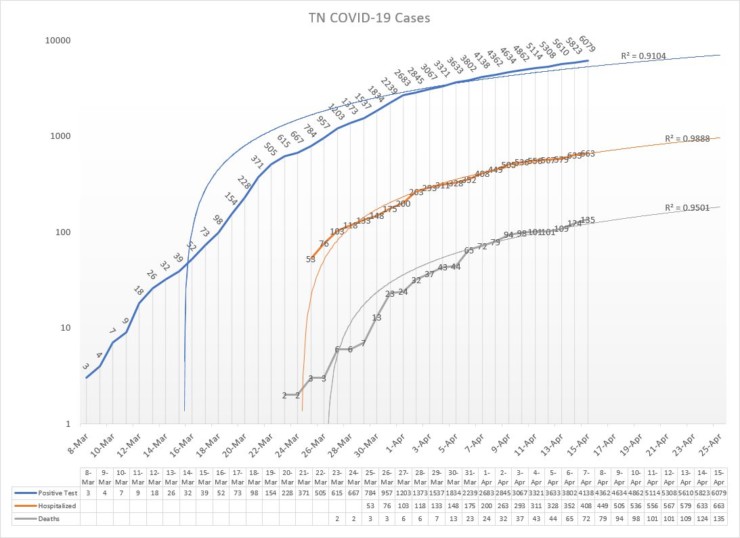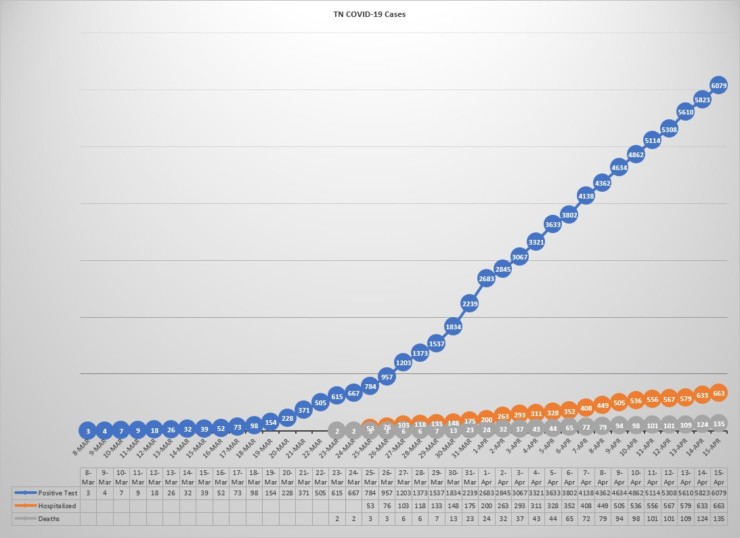
The growth rate of COVID-19 cases in Tennessee has been in single digits for eight days and at or below 10 percent for two weeks.
This week, Tennessee Governor Bill Lee said the single-digit growth rate is encouraging.
“Our curve is flattening,” Tennessee Department of Health Commissioner Lisa Piercey said during a press conference Monday. She said people need to continue doing what they are doing, especially as the state considers re-opening the economy in phases in May.
“We’re not out of the woods yet,” Lee said during that press conference. He said the state doesn’t intend to lift social distancing efforts, even if other requirements change.
“Social distancing is going to be a way of life for Tennesseans going forward,” Lee said. That will be true until there is a vaccine, he said.
On Monday, the governor announced a statewide stay-at-home order would be extended through April 30. On Wednesday, he recommended that schools in Tennessee remain closed though the end of the school year.
In the most recent update, from Wednesday, the Tennessee Department of Health reported 6,079 COVID-19 cases in Tennessee with 135 deaths. There have been 663 hospitalizations and 2,196 recoveries.
In the past eight days, since April 8, the growth rate in COVID-19 cases in Tennessee has been at or below about 6 percent.
But in that same time period, the growth rate in the number of deaths has generally been higher, up to 19 percent.
COVID-19 is a contagious respiratory illness that can be deadly.
The rate of doubling for both COVID-19 cases and deaths appears to be lengthening, in terms of number of days. The 6,079 cases reported Wednesday was roughly a doubling of the 3,067 cases reported April 3—12 days earlier. The 135 deaths reported Wednesday was roughly a doubling of the 65 deaths reported April 6—9 days earlier. Those are both longer doubling periods than reported earlier.
Meanwhile, the number of recoveries is growing, usually by double-digit percentages.
One of the reasons health officials have given to try to “flatten the curve,” slowing the spread of COVID-19, is to keep hospitals and health care systems from becoming overwhelmed. Lee said hospital capacity in Tennessee remains stable, with 5,287 open staffed hospital beds as of Monday.
Tennessee’s Unified Command Group said there are 12,000 staffed beds in the state. About half, 5,700, were occupied as of Monday. There is a surge capacity of about 17,000, and there is plenty of capacity, officials said. There are more than 2,000 staffed intensive care beds in Tennessee, and about 1,200 were occupied as of Monday, with a surge capacity of 4,000. The state is working on a contingency plan around the four major cities (Chattanooga, Knoxville, Nashville, and Memphis), working with the Army Corps of Engineers.
The percentage of COVID-19 cases in Tennessee has been growing among patients who are 51-60 years old. For days, maybe weeks, the largest number of cases has been among patients who are 21-30 years old. That’s still true.
But the number of cases among other age groups is rising in comparison. Here was the breakdown as of Wednesday:
- 0-10 years old: 70 cases (1 percent) and 1 death (1 percent)
- 11-20: 272 cases (4 percent) and 0 deaths (0 percent)
- 21-30: 1,189 cases (20 percent) and 1 death (1 percent)
- 31-40: 958 cases (16 percent) and 1 death (1 percent)
- 41-50: 969 cases (16 percent) and 7 deaths (5 percent)
- 51-60: 1,076 cases (18 percent) and 14 deaths (10 percent)
- 61-70: 731 cases (12 percent) and 34 deaths (25 percent)
- 71-80: 353 cases (6 percent) and 33 deaths (24 percent)
- 81 and older: 197 cases (3 percent) and 44 deaths (33 percent)
- Pending: 264 cases (4 percent)
The number of cases in Anderson County increased by one to 16 on Wednesday. There has been one death in the county, 11 recoveries, and 459 negative tests.
See the daily Tennessee Department of Health COVID-19 report here.

Leave a Reply